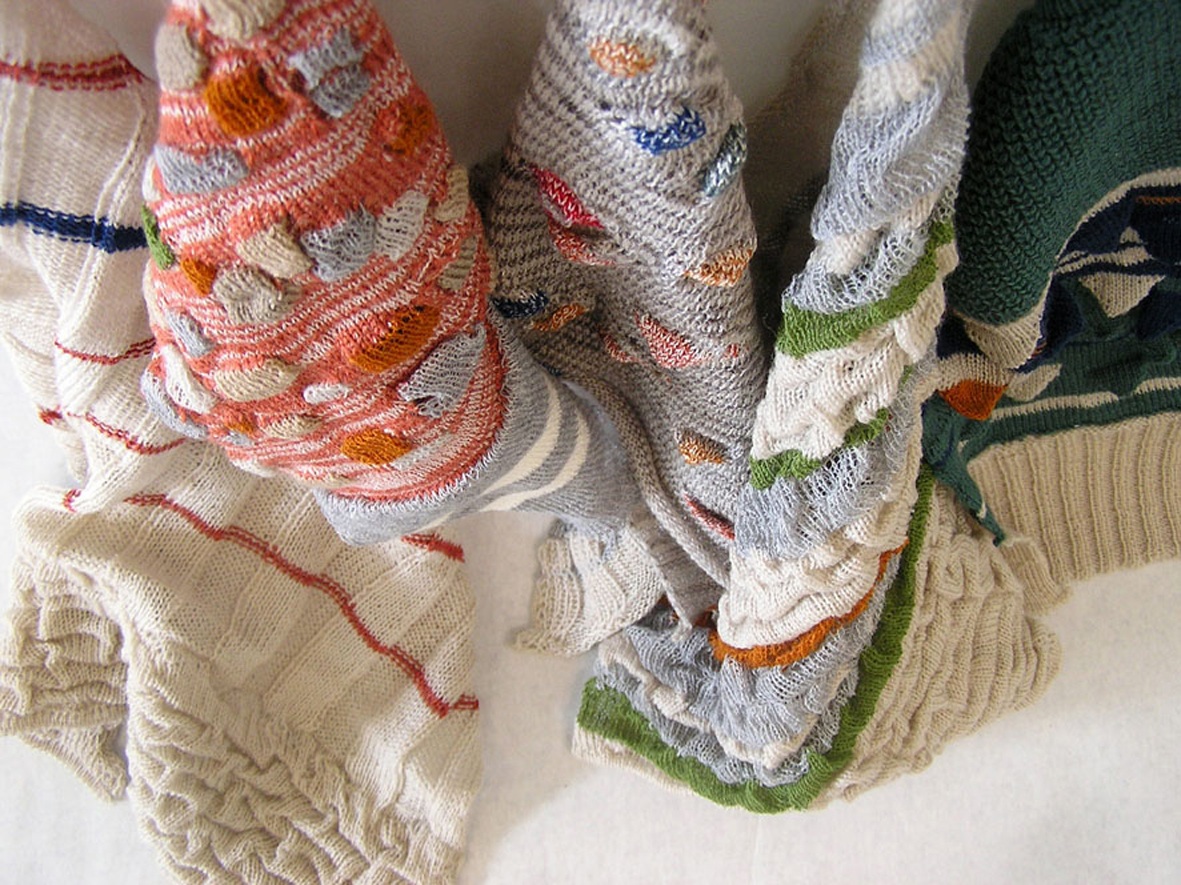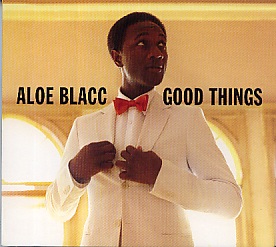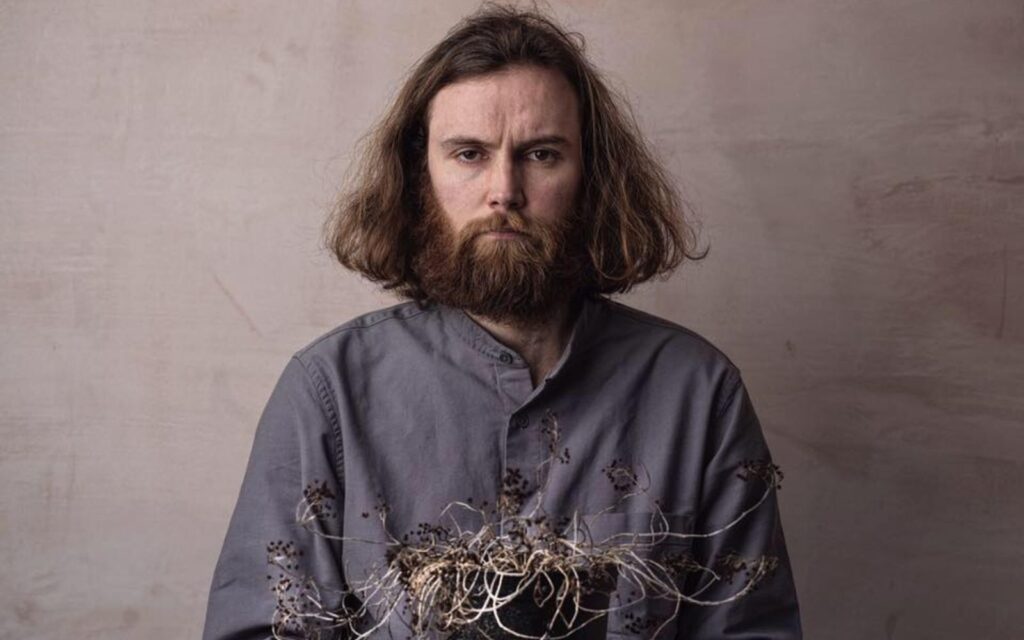Apophenia is the name of a special brain state that creative people sometimes find themselves within
Apophenia is the name of a special brain state that creative people sometimes find themselves within, and also the name of the graduate exhibition from RMIT’s Textile Design Graduate Exhibition, one of a series of shows from RMIT as part of their 2010 Art And Design Exhibitions which celebrate the release of creative graduates into the big wide world, where they’ll make our lives prettier, better and generally more interesting with their rather impressive skill sets and beautifully different ways of thinking.
“Apophenia is apparently some sort of creative state…” begins Julie Newton, Textille Design graduate and exhibiting artist in Apophenia. Her friend and classmate, Milly Gamlin, finishes her sentence: “…that the mind goes into. It grabs different perceptions and forms patterns from them.
“There’s some sort of link with creative people and making pattern associations between things,” she continues, “whether it’s actual patterning or just noticing a series of things and making connections between them. We’ve just kind of taken that idea and made a very literal thing of it. Because we’re pattern makers.”
They certainly are. With extensive training in all things pattern, textile, sensory and design related, the graduates from RMIT’s Textile And Design course come out with an impressive skillset which, for Apophenia, is showcased in a selection of their work as well as their curation of the exhibition.
“It’s pretty much self-run by the students this year because usually RMIT puts on a grad show but they have a different degree exhibition, so we’re having two exhibitions,” Julie explains. Both girls worked on the curation team, which was a learning curve in itself but a valuable one. “We had to try to work out how to group everyone individually but also collectively because we’re from the same class and group but we’re all going different directions,” says Milly.
“We haven’t been exactly working towards this theme,” Julie adds. “It’s more of a collection of everybody’s work over the year. So we’re trying to work out how to balance 17 different students who want to submit everything that they can put on the table. Everyone’s probably put in four or five pieces each so there’s a lot on show. Basically the set up is we’ll have one wall dedicated to each student so they can have their designated space and get a sense of what they’re about. There will be little collective exhibitions as well of larger projects.”
The larger projects generally come from group assignments set throughout the term. For example, one of them required the Textile Design classes to collaborate with the Architecture classes, resulting in an explosion of ideas and new ways of thinking about space and texture.
“We have a collective architecture space [in the exhibition],” explains Milly. “We had to do a project to do with textiles and architecture, trying to use textile techniques with architecture, so creating architectural space but on a small scale with textile techniques. So [all those works are] all together.”
As you can image, with a class of 17, there must be a lot of pressure to keep things new and interesting – and for Textile Design students that usually means using a broad and diverse range of materials. Apophenia will be a delight for the senses. “Anything and everything!” Julie exclaims happily. “We have three different majors so you can do screenprinting, knitting or weaving and within that you can pretty much go nuts with whatever you want, but depending on what each student wants to focus on when they graduate… [Milly and I are] both print majors but I barely did any screenprinting in my final year.”
“A lot of people do a lot of illustration, because it’s like the first step before you get to the textile concepts,” Milly adds.
But I’m quite curious – how much can you really do with knitting these days? The humble art for grandmothers and Christmas jumpers has now made quite a transition into the glamourous world of design. “[They work in] a big studio with this big knitting machine that almost kind of looks like a keyboard,” Julie muses. “We don’t know much about them because after first year you really focus on your own specialised area. So when I hear the knitters talking sometimes it’s like they’re speaking a whole other language.” And do they make clothes with this crazy machine? “They can and a few of them have made garments,” says Julie, but it’s really more about deconstructing clothes than constructing them.
“The fashion designers come to us and work with us to get their [fully-formed] ideas,” Milly explains. They’re doing a lot of explaining because for most people, the words ‘textile design’ are sort of meaningless, and it turns out they mean quite a lot. “They’ll do the structure of the garments and they’ll have ideas for colour and embellishment but we really just work on colour and embellishment and pattern.”
“It works out quite perfectly because we do carry the same skill set as graphic designers,” adds Julie, “but at the same time with something like stationery where we’re really trained to think about ranges and coordination and placement and repeating patterns, it flows really naturally. It also goes across different platforms like bed linen or crockery.”
Stationery design is one of the areas that Julie and Milly are quite interested in, with hopes to create their own small business and use their skills from the RMIT course to create ranges of personalised stationery as well as a variety of other commissions. For Julie, paper-based work is something she’s been immersed in all year.
“My project for the year has been this popup book that I went crazy working on,” she laughs. “It’s an original story, just a rhyming children’s’ book but it can be appreciated from adult eyes as well and I think children and adults would read it quite differently. But it’s completely illustration-based, all starting with hand-generated imagery and bringing that into photoshop and working my way out with filters and additional things.
“It was quite interesting because I had no prior knowledge of the technicalities of popups at all or about 3D forms and paper – stuff we’re not trained at all do to – and even though there were projects catered towards it, like the architecture thing, mainly we deal with 2D surfaces, that’s our whole schtick – we’re surface designers, not structure designers.
“So it’s a little book which folds out to about four and a half metres of illustration. It’s just packed full of popups and pull tabs and interactive features and hopefully that’ll be cool!”
And despite Milly’s work looking just like a beautiful origami work, it’s actually made of fabric. “That’s my architecture work,” she clarifies. “I’m more interested in fashion textiles and manipulation techniques with print techniques because I’m quite interested in how you can have really complicated textiles which have manipulations in the printed textiles. So I’ve tried to concentrate on that for a few of my projects and for that project I did an origami technique and it’s also pleating so it’s expandable and contractable. I used that with a textile technique and manipulated the fabric so it holds that shape. It looks like paper, but it’s fabric. I used a technique that eats away at the fabric to create holes – some of those fabrics are really manipulated.”
Although you may get lost in the beautiful world of images, textures and feelings of Apophenia, the girls assure me that their degree is not all about off-with-the-fairies waffle. “It’s very skills-based – we’re taught so many practical things. There are things you can learn in this course that you can’t learn anywhere else,” confirms Julie. “They say that our difference from graphic designers is that we use a lot of hand-done techniques, a lot of cut and paste and we use a lot of different media,” Milly adds. “This course is very good because they really try to push us to be as creative as we can be, but then they also give us all the technical training and they’re quite thorough.”
And because of that, life after uni isn’t a scary prospect – at least not as much as it might be for a straight Arts Graduate.
“There are jobs for textile designers, but it’s quite a small industry in Australia. But because we’re the only degree textile course in Australia, it’s pretty reputable so we can pretty confidently apply for jobs… Melbourne does support a lot of small industries and a lot of textile designers do start their own small businesses from doing our course,” says Milly.
“They do prepare us for that as well – there’s an entire course in the final semester dedicated to business and careers. They really try and think about how it’s going to be relevant in the industry and what we’re going to need to be able to compete with people for jobs because there’s so much digital design going on right now – we’ll be going for a lot of the same jobs as graphic designers,” Julie says. “We can actually appreciate something of quality that takes time and is made from scratch by hand.”
Apophenia exhibits a broad range of work from the RMIT Bachelor of Arts (Textile Design) course as their Graduate Exhibition. It’s part of a broader range of RMIT Graduate Exhibitions, which you can check out at rmit.edu.au/dsc/exhibitions.
Apophenia is at fortyfivedownstairs from November 30 until December 4. Gallery hours are from Tuesday – Friday, 11am-5pm and Saturday from 12pm – 4pm.







